Plan and sketch a potential final project
I have an idea of making a special accoustic guitar:

- I am curious to see if the playbackwill not interfere with the microphone to create an echo
I have an idea of making a special accoustic guitar:


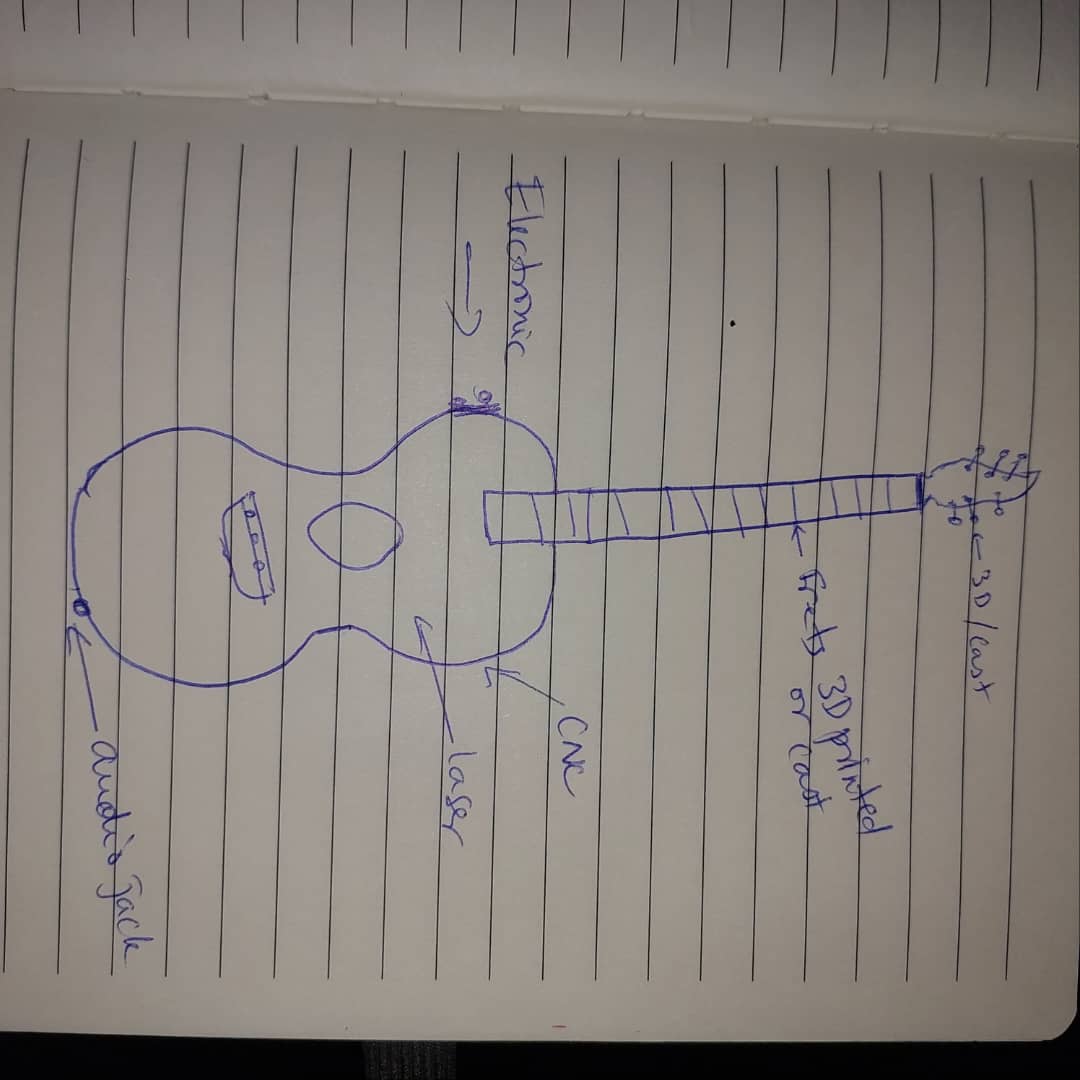
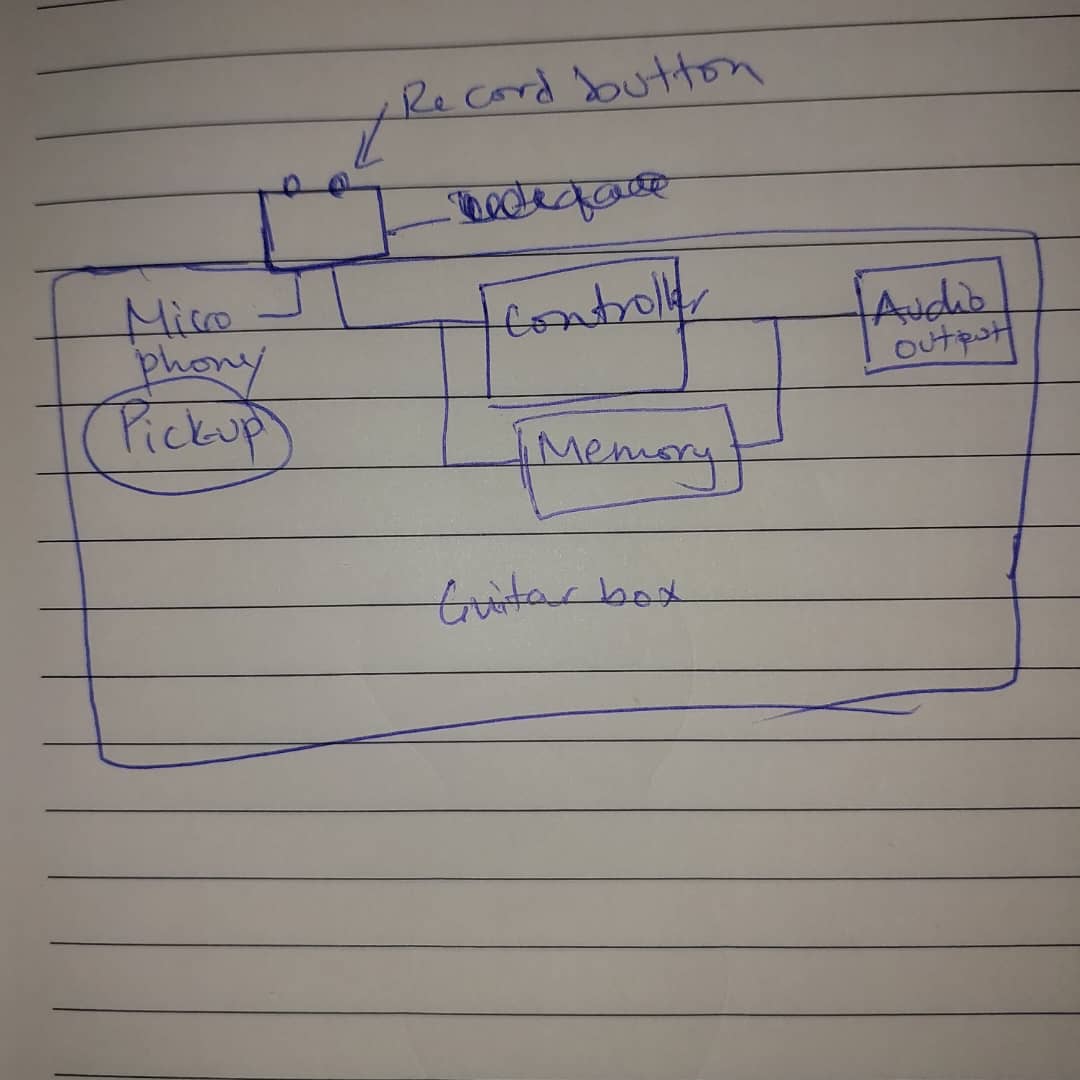
But in the end

.jpeg)
This page is a summary of the work done on the final project.
A more detailed process is found on the Project requirements/presentation week page.
Its link is Here.
Welcome to the summary
Mid work this is one note list of todos i had! Such a journey!
Plan for dissemination of my project:
1. finish the embedded system part by Monday the 29th of May
2. Buy wood and cut the guitar by Saturday the 3rd June
3. Assembly and testing by sunday the 4th June
4. Make a video for final presentation before the 6th of June
5. Document everything about my final project before the 7th of June.
So far i have started working on the electronics part
I also sent in the request for material from the fablab
These are the shapes i cut on acrylic using a laser cutter to be able to visualize the project.
Thinking about my Summary slides
Questions to be answered
What will it do?
My proposed project is a guitar that has the capacity to record a priece of music and play it back on loop.
The user of the guitar may choose to play another live piece of music. Then it will sound like two pieces of music are playing at the same time.
Who's done what beforehand?
In the fab academy, I saw people who did the boom box, another one who did “Legos” for Sound
Physical Modular Sound Blocks for sound and music and many other projects.
However none of them resembled mine exactly.
On the market you may find guitar pedals with loops. However they are costly and it is a separate tool away from the guitar. MINE WILL BE INTEGRATED INSIDE A GUITAR.
What will you design?
1. I will design the electronic circuit for the whole process of recording, writing on an SD card, playing back on a loop.
2. I will design the guitar frame: Acoustic version
3. Integrate everything together.
What materials and components will be used?
here is the list of material i will use:
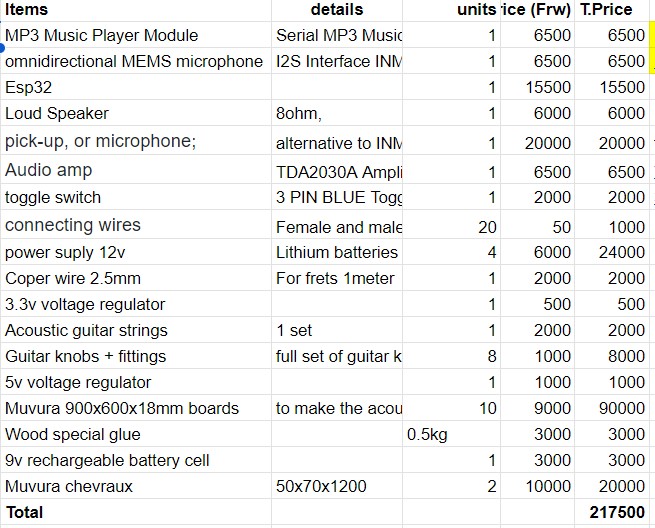 Not to mention the PLA that will be used in the printing of a case.
Where will they come from?
Most of these will be purchased by the fablab.
If there is additional cost, i will cover.
All items can be found on local market. I have links to the shops where i can find them.
Items like hardwood boards will be procured by me going to the market place and picking them.
How much will they cost?
Items mentioned in the colored table have a cost estimation of around 220USD
What parts and systems will be made?
As i mentioned:
The electornic part and,
the guitar frame
What processes will be used?
For the electronic part, I will program the SP32 to do tasks then connect the microphone and the speaker with its amplifier.
For the frame i will use the ShopBot to cut parts that i can.
Originally i had thought to make a mold and cast the tuning knobs but I was unable to find the right material for that.
Therefore i will buy the ready-made knobs, the strings and other things i will not be able to print.
Then i will assemble and test.
What questions need to be answered?
1. How to record sound/music and write it on an SD card?
2. How to immediately playback sound/ music?
3. Can the system be attached together?
4. Can the sound come out of the case?
How will it be evaluated?
My project should be evaluated on following criteria:
1. Is the sound coming out the one we recorded?
2. Does the system look like a guitar?
3. was it made by using computer controlled machines?
Also to have an idea of what will be done on the guitar frame
Not to mention the PLA that will be used in the printing of a case.
Where will they come from?
Most of these will be purchased by the fablab.
If there is additional cost, i will cover.
All items can be found on local market. I have links to the shops where i can find them.
Items like hardwood boards will be procured by me going to the market place and picking them.
How much will they cost?
Items mentioned in the colored table have a cost estimation of around 220USD
What parts and systems will be made?
As i mentioned:
The electornic part and,
the guitar frame
What processes will be used?
For the electronic part, I will program the SP32 to do tasks then connect the microphone and the speaker with its amplifier.
For the frame i will use the ShopBot to cut parts that i can.
Originally i had thought to make a mold and cast the tuning knobs but I was unable to find the right material for that.
Therefore i will buy the ready-made knobs, the strings and other things i will not be able to print.
Then i will assemble and test.
What questions need to be answered?
1. How to record sound/music and write it on an SD card?
2. How to immediately playback sound/ music?
3. Can the system be attached together?
4. Can the sound come out of the case?
How will it be evaluated?
My project should be evaluated on following criteria:
1. Is the sound coming out the one we recorded?
2. Does the system look like a guitar?
3. was it made by using computer controlled machines?
Also to have an idea of what will be done on the guitar frame

CNC
the guitar frame can be made using a DXF file to make the case on plywood with 3mm thickness
I started with cardboard to avoid wasting Material.
 I stacked a number of similar parts on each other to have the shape
I stacked a number of similar parts on each other to have the shape
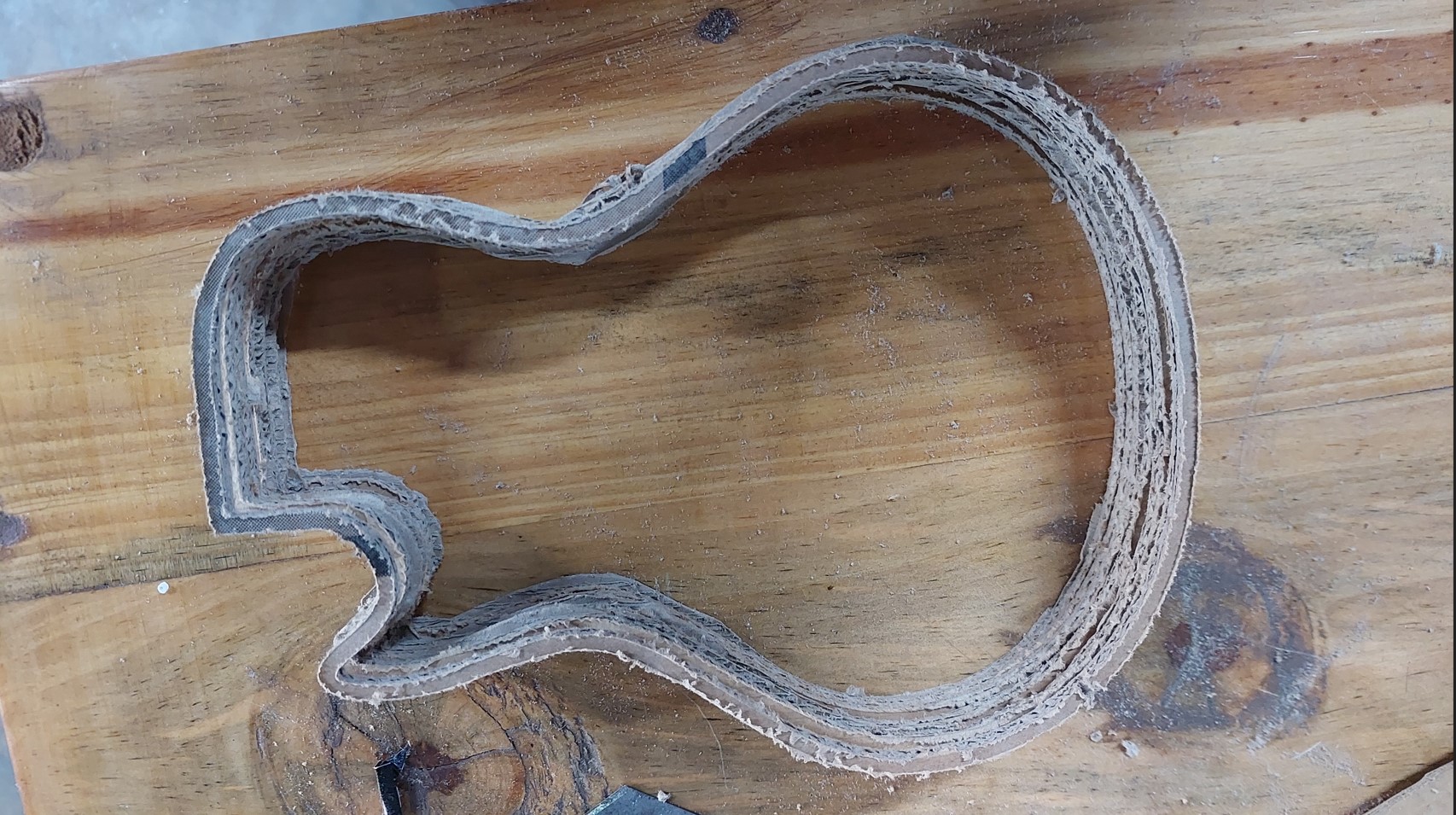 After all this is the frame i worked with
After all this is the frame i worked with

Electronics
As mentioned in the project development week,
it was too complicated for me to write music (audio) on an HC SD card using just SP32
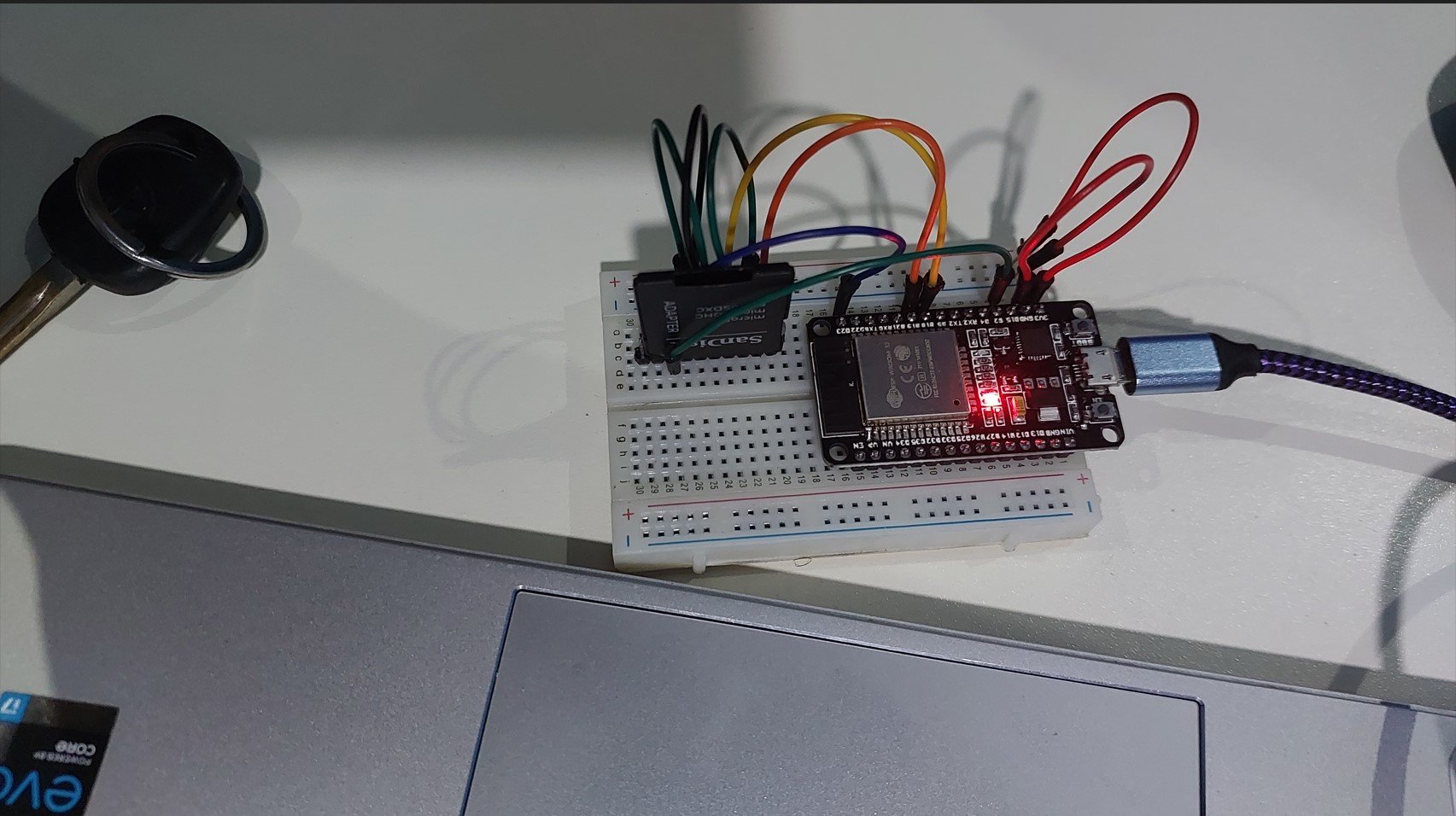 I opted on using ISD1820 voice Module which records and plays back an audio input, then use the ESP32 to control a boutton like this:
Longpress: Start recording mode
Simplepress: playback the recorded music in loop indefinetely
I had to find a PCB board to house all my main components
I opted on using ISD1820 voice Module which records and plays back an audio input, then use the ESP32 to control a boutton like this:
Longpress: Start recording mode
Simplepress: playback the recorded music in loop indefinetely
I had to find a PCB board to house all my main components


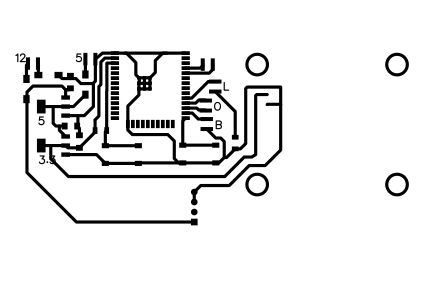
 Using Roland Miller was bringing a lots of problem since the screw that holds the tool was not tightening and the bed seemed not well leveled, I opted to mill the PCB using a CNC
A blue elephant ELECNC6090 Chinese model.
Steps i took:
1. convert the exported svg of traces into a png file. I used inkscape and kept the ratio of 1:1 always
2. I used the Aspire CAM to create a pocket toolpath to clear the copper out and leave the traces alone.
3. I editted the tool diameter, the feedrate and plunge rate to match the board details. 0.16mm pocket depth to remove copper and 1.8mm to cut out the contour.
Bad results from Rml
Using Roland Miller was bringing a lots of problem since the screw that holds the tool was not tightening and the bed seemed not well leveled, I opted to mill the PCB using a CNC
A blue elephant ELECNC6090 Chinese model.
Steps i took:
1. convert the exported svg of traces into a png file. I used inkscape and kept the ratio of 1:1 always
2. I used the Aspire CAM to create a pocket toolpath to clear the copper out and leave the traces alone.
3. I editted the tool diameter, the feedrate and plunge rate to match the board details. 0.16mm pocket depth to remove copper and 1.8mm to cut out the contour.
Bad results from Rml
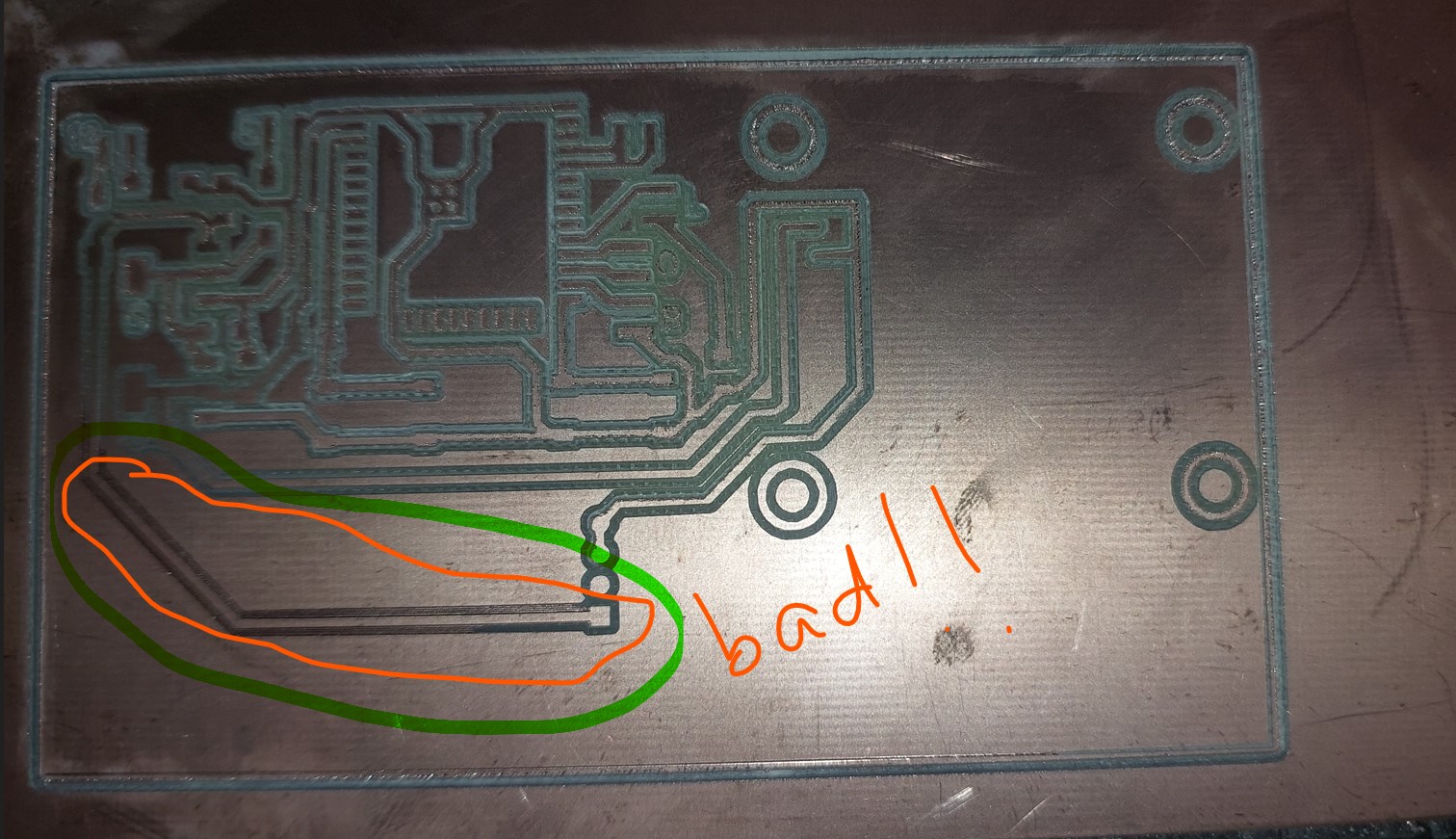 clean traces of CNC
clean traces of CNC
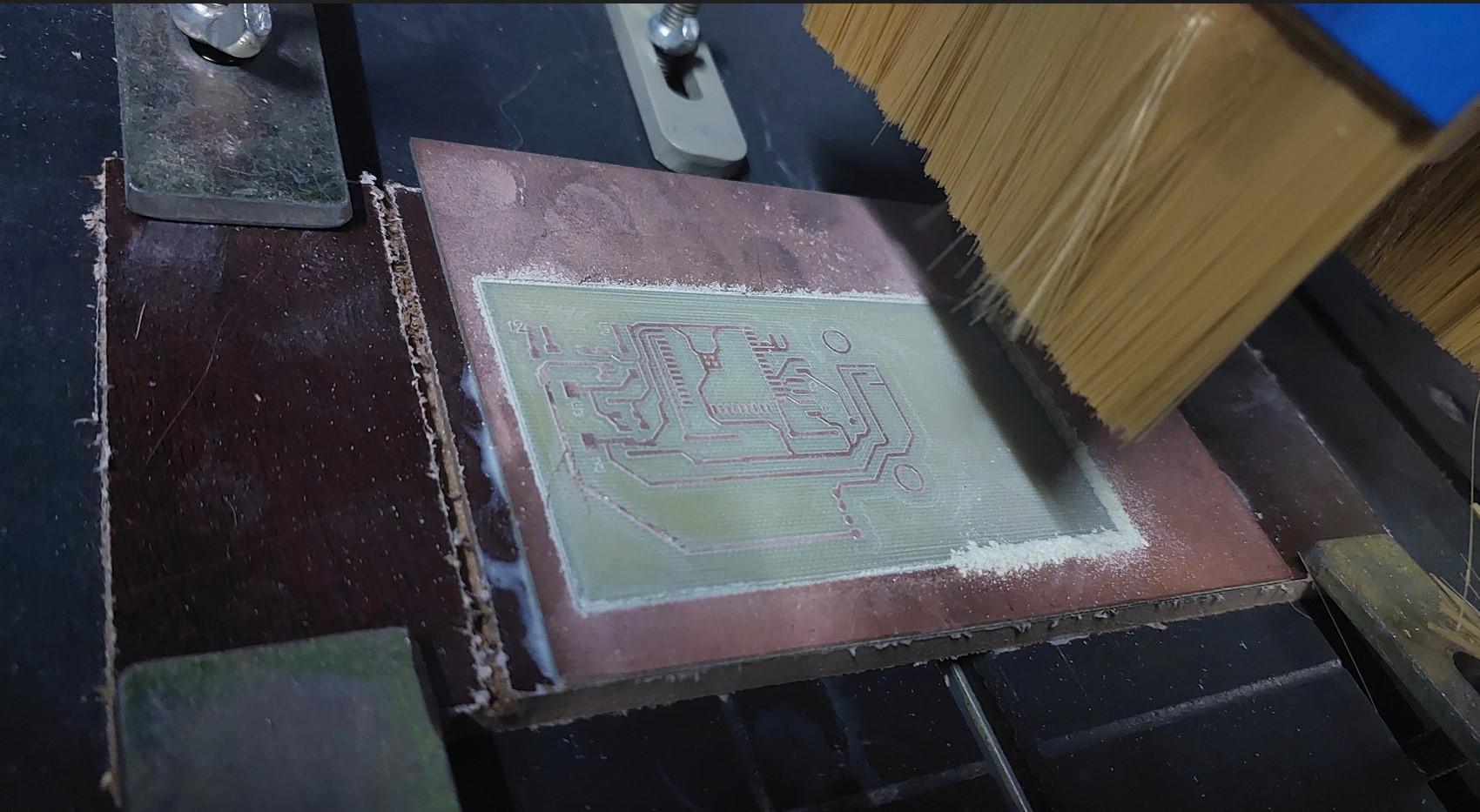 I felt happy of the outcome, considering the night i had spent trying the other machine that wouldn't work properly.
I felt happy of the outcome, considering the night i had spent trying the other machine that wouldn't work properly.
 Please note that i recognize the health risks associated with milling PCB with this type of CNC. If someone else has to do this, let them consider using serious PPE for their breathing
then SOLDERED components on
Please note that i recognize the health risks associated with milling PCB with this type of CNC. If someone else has to do this, let them consider using serious PPE for their breathing
then SOLDERED components on
 Uploaded in the control program
static const int buttonPin = 4; // switch pin
static const int Feedback_Pin = 18; // Feedback pin from ISD1820
int buttonStatePrevious = 1; // previousstate of the switch
unsigned long minButtonLongPressDuration = 600; // Time we wait before we see the press as a long press
unsigned long buttonLongPressMillis; // Time in ms when we the button was pressed
bool buttonStateLongPress = false; // True if it is a long press
const int intervalButton = 50; // Time between two readings of the button state
unsigned long previousButtonMillis; // Timestamp of the latest reading
unsigned long buttonPressDuration; // Time the button is pressed in ms
unsigned long currentMillis; // Variabele to store the number of milleseconds since the Arduino has started
unsigned long startRectime;
unsigned long EndRectime;
bool playE = false;
bool reco = false;
const int rec = 16;
const int play = 17;
int timer_del = 0;
int timerDel2 = 0;
int recState = 0;
int playState = 0;
int LED_INDICATOR = 5;
void setup() {
Serial.begin(115200);
pinMode(buttonPin, INPUT_PULLUP);
pinMode(rec, OUTPUT);
pinMode(play, OUTPUT);
pinMode(LED_INDICATOR,OUTPUT);
pinMode(Feedback_Pin, INPUT);
digitalWrite(rec, 0);
digitalWrite(play, playState);
}
// Function for reading the button state
void readButtonState() {
if (currentMillis - previousButtonMillis > intervalButton) {
int buttonState = digitalRead(buttonPin);
if (buttonState == 0 && buttonStatePrevious == 1 && !buttonStateLongPress) {
buttonLongPressMillis = currentMillis;
buttonStatePrevious = 0;
Serial.println("Button pressed");
}
buttonPressDuration = currentMillis - buttonLongPressMillis;
if (buttonState == 0 && !buttonStateLongPress && buttonPressDuration >= minButtonLongPressDuration) {
buttonStateLongPress = true;
buttonStatePrevious = 0;
Serial.println("Button long pressed");
getting_ready_for_record();
reco = true;
}
if (buttonState == 1 && buttonStatePrevious == 0) {
buttonStatePrevious = 1;
buttonStateLongPress = false;
digitalWrite(LED_INDICATOR, HIGH);
delay(500);
digitalWrite(LED_INDICATOR, LOW);
delay(500);
Serial.println("Button released");
if (buttonPressDuration < minButtonLongPressDuration) {
Serial.println("Button pressed shortly");
playE = true;
}
}
previousButtonMillis = currentMillis;
}
}
void loop() {
currentMillis = millis(); // store the current time
readButtonState(); // read the button state
digitalWrite(play, playState);
//if a single press occurs, playback starts looping
if (playE) {
playBack();
}
//if long pressed the button, record will start
if (reco) {
digitalWrite(LED_INDICATOR, HIGH);
record();
reco = false;
}
}
//recording function ---recording time may vary from 1 upto 20 seconds
void record() {
Serial.println("Recording");
long startTime = millis()/1000;
long duration = 20; //up to 20sec
while (millis()/1000 < startTime + duration) {
digitalWrite(rec, 1);
}
digitalWrite(rec, 0);
}
//playback function
void playBack() {
playState=1;
digitalWrite(play, playState);
int timer_delay=timer_del;
while(timer_delay>0){
playState = 0;
timer_delay=timer_delay-1;
digitalWrite(play, playState);
}
}
//
// if (playState == 1) {
// Serial.println("Playing");
// if (millis() / 1000 - timer_del >= 1) {
// playState = 0;
// timer_del = timer_del+(millis() / 1000);
// }
// } else {
// if (millis() / 1000 - timer_del >= 0.1) {
// playState = 1;
// timer_del = timer_del+(millis() / 1000);
// }
// }
//}
void getting_ready_for_record(){
int timer=1;
while(timer<=5){
digitalWrite(LED_INDICATOR, HIGH);
delay(500);
digitalWrite(LED_INDICATOR, LOW);
delay(500);
timer=timer+1;
}
startRectime=millis();
attachInterrupt(digitalPinToInterrupt(Feedback_Pin),recordingstate,RISING); // function for creating external interrupts at pin2 on Rising (LOW to HIGH vice versa)
}
void recordingstate(){
digitalWrite(LED_INDICATOR, LOW);
detachInterrupt(Feedback_Pin);
reco = false;
EndRectime=millis();
timer_del= (EndRectime-startRectime)/1000;
Serial.println("Recording ended with period of "+String(timer_del)+"sec");
}
Uploaded in the control program
static const int buttonPin = 4; // switch pin
static const int Feedback_Pin = 18; // Feedback pin from ISD1820
int buttonStatePrevious = 1; // previousstate of the switch
unsigned long minButtonLongPressDuration = 600; // Time we wait before we see the press as a long press
unsigned long buttonLongPressMillis; // Time in ms when we the button was pressed
bool buttonStateLongPress = false; // True if it is a long press
const int intervalButton = 50; // Time between two readings of the button state
unsigned long previousButtonMillis; // Timestamp of the latest reading
unsigned long buttonPressDuration; // Time the button is pressed in ms
unsigned long currentMillis; // Variabele to store the number of milleseconds since the Arduino has started
unsigned long startRectime;
unsigned long EndRectime;
bool playE = false;
bool reco = false;
const int rec = 16;
const int play = 17;
int timer_del = 0;
int timerDel2 = 0;
int recState = 0;
int playState = 0;
int LED_INDICATOR = 5;
void setup() {
Serial.begin(115200);
pinMode(buttonPin, INPUT_PULLUP);
pinMode(rec, OUTPUT);
pinMode(play, OUTPUT);
pinMode(LED_INDICATOR,OUTPUT);
pinMode(Feedback_Pin, INPUT);
digitalWrite(rec, 0);
digitalWrite(play, playState);
}
// Function for reading the button state
void readButtonState() {
if (currentMillis - previousButtonMillis > intervalButton) {
int buttonState = digitalRead(buttonPin);
if (buttonState == 0 && buttonStatePrevious == 1 && !buttonStateLongPress) {
buttonLongPressMillis = currentMillis;
buttonStatePrevious = 0;
Serial.println("Button pressed");
}
buttonPressDuration = currentMillis - buttonLongPressMillis;
if (buttonState == 0 && !buttonStateLongPress && buttonPressDuration >= minButtonLongPressDuration) {
buttonStateLongPress = true;
buttonStatePrevious = 0;
Serial.println("Button long pressed");
getting_ready_for_record();
reco = true;
}
if (buttonState == 1 && buttonStatePrevious == 0) {
buttonStatePrevious = 1;
buttonStateLongPress = false;
digitalWrite(LED_INDICATOR, HIGH);
delay(500);
digitalWrite(LED_INDICATOR, LOW);
delay(500);
Serial.println("Button released");
if (buttonPressDuration < minButtonLongPressDuration) {
Serial.println("Button pressed shortly");
playE = true;
}
}
previousButtonMillis = currentMillis;
}
}
void loop() {
currentMillis = millis(); // store the current time
readButtonState(); // read the button state
digitalWrite(play, playState);
//if a single press occurs, playback starts looping
if (playE) {
playBack();
}
//if long pressed the button, record will start
if (reco) {
digitalWrite(LED_INDICATOR, HIGH);
record();
reco = false;
}
}
//recording function ---recording time may vary from 1 upto 20 seconds
void record() {
Serial.println("Recording");
long startTime = millis()/1000;
long duration = 20; //up to 20sec
while (millis()/1000 < startTime + duration) {
digitalWrite(rec, 1);
}
digitalWrite(rec, 0);
}
//playback function
void playBack() {
playState=1;
digitalWrite(play, playState);
int timer_delay=timer_del;
while(timer_delay>0){
playState = 0;
timer_delay=timer_delay-1;
digitalWrite(play, playState);
}
}
//
// if (playState == 1) {
// Serial.println("Playing");
// if (millis() / 1000 - timer_del >= 1) {
// playState = 0;
// timer_del = timer_del+(millis() / 1000);
// }
// } else {
// if (millis() / 1000 - timer_del >= 0.1) {
// playState = 1;
// timer_del = timer_del+(millis() / 1000);
// }
// }
//}
void getting_ready_for_record(){
int timer=1;
while(timer<=5){
digitalWrite(LED_INDICATOR, HIGH);
delay(500);
digitalWrite(LED_INDICATOR, LOW);
delay(500);
timer=timer+1;
}
startRectime=millis();
attachInterrupt(digitalPinToInterrupt(Feedback_Pin),recordingstate,RISING); // function for creating external interrupts at pin2 on Rising (LOW to HIGH vice versa)
}
void recordingstate(){
digitalWrite(LED_INDICATOR, LOW);
detachInterrupt(Feedback_Pin);
reco = false;
EndRectime=millis();
timer_del= (EndRectime-startRectime)/1000;
Serial.println("Recording ended with period of "+String(timer_del)+"sec");
}
3D DESIGN AND PRINTING
I designed the box in which the components will go
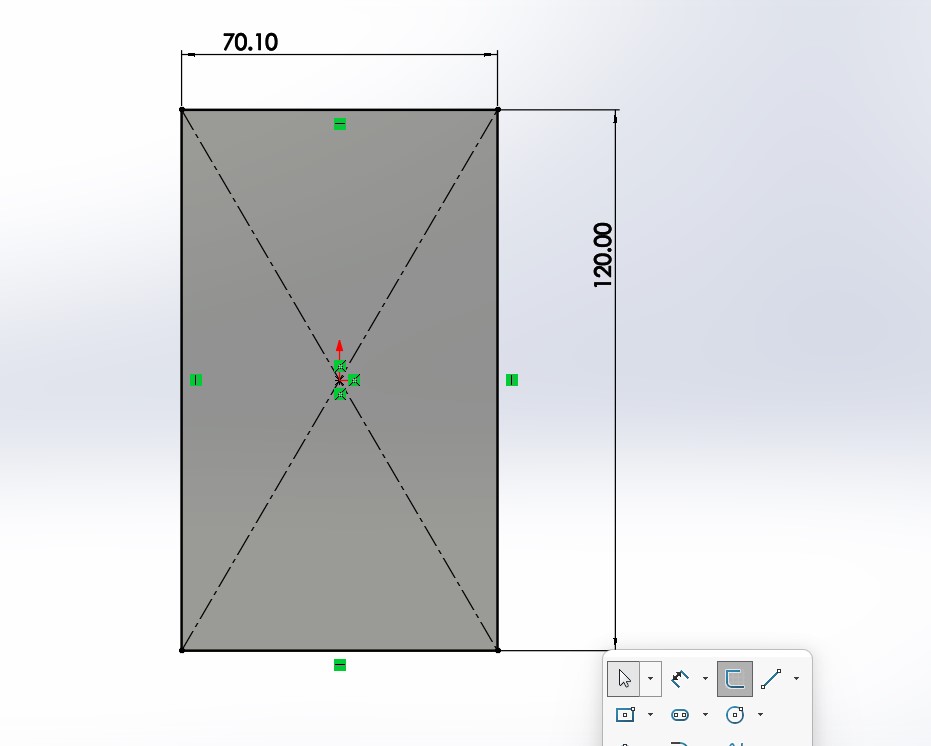
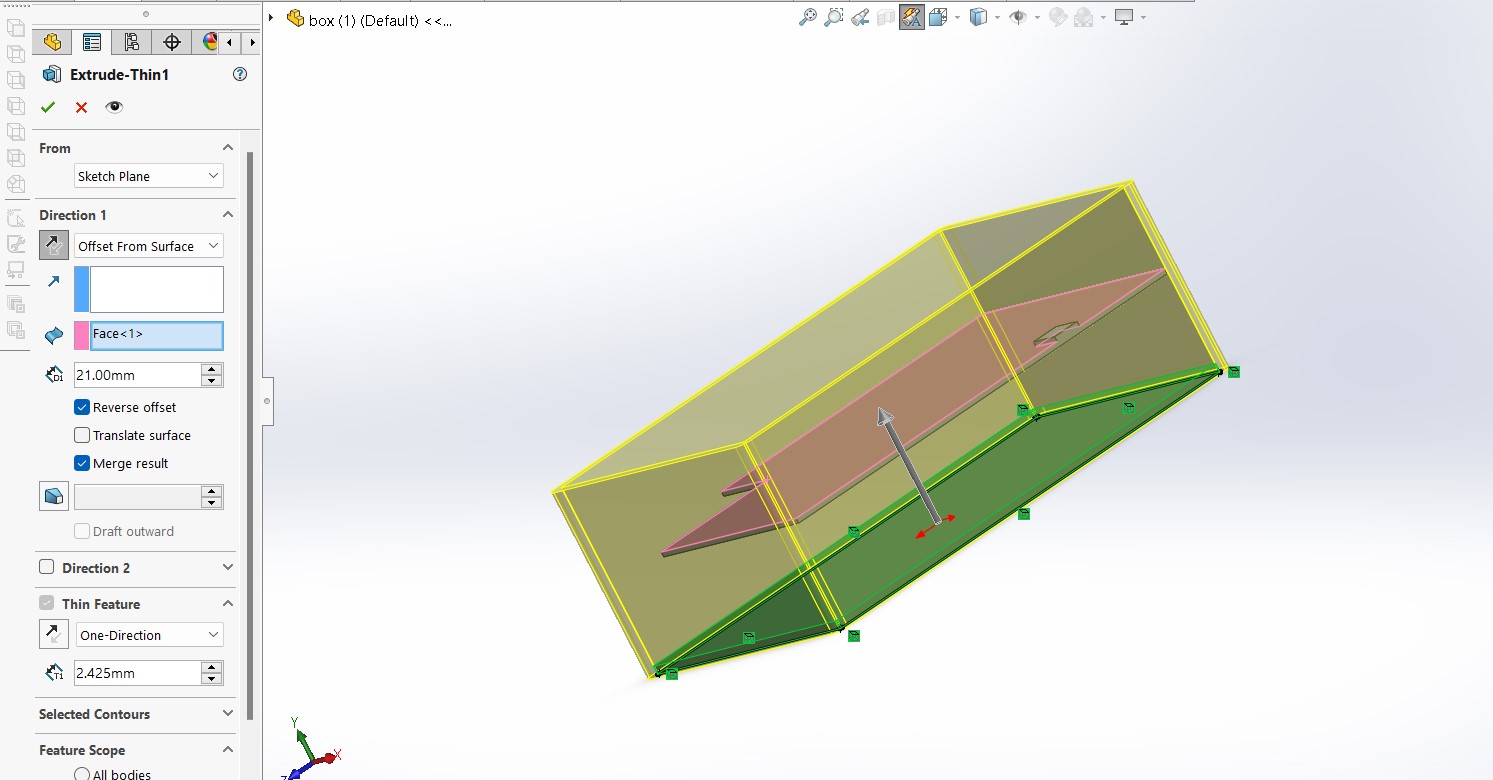 The box printing
The box printing
 The components fit in well
The components fit in well
 Put the components inside the guitar and masked a bit for painting
Put the components inside the guitar and masked a bit for painting
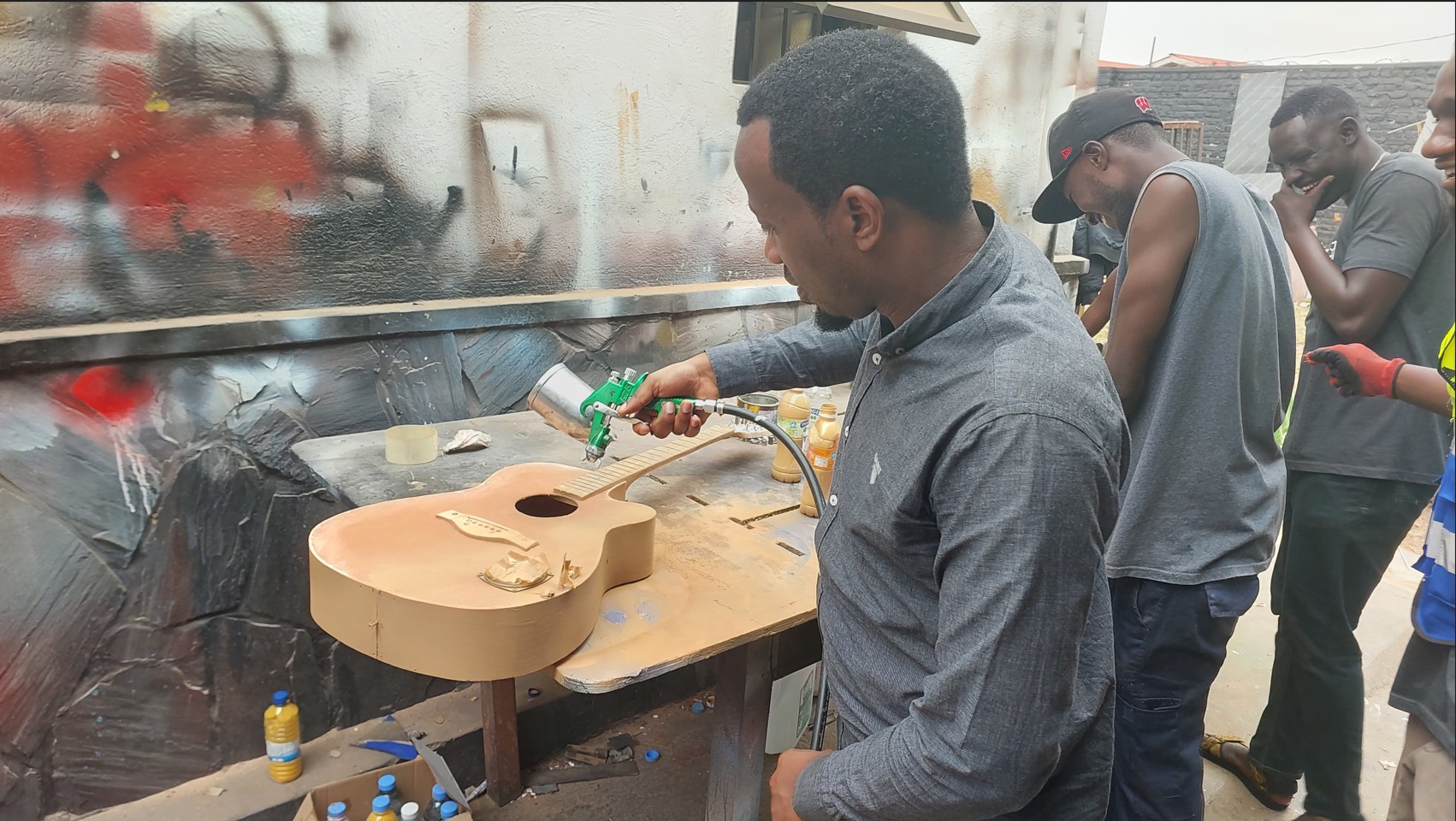 Now the guitar works:
Now the guitar works:
 back
back
 front
Again for more details
front
Again for more details
A more detailed process is found on the Project requirements/presentation week page.
Its link is Here.
thanks fabacademy!